Effects of Physical and Chemical Modification of Sunflower Cake on Polyurethane Composite Foam Properties
Abstract
:1. Introduction
2. Materials and Methods
2.1. Materials
2.2. Impregnation of SC with Rapeseed Oil (SC_O)
2.3. Silanization of SC (SC_S)
2.4. Synthesis of PUR Composite Foams
2.5. Sample Characterization
3. Results and Discussion
3.1. Topography and an Average Size of SC Fillers
3.2. The Impact of SC Fillers on Viscosity and Processing Parameters of Polyol Premixes
3.3. The Impact of SC Fillers on Morphology, Apparent Density, and Thermal Conductivity of PUR Composites
3.4. The Impact of SC Fillers on Mechanical Performances of PUR Composites
3.5. The Impact of SC Fillers on Water Uptake of PUR Composite Foams
3.6. The Impact of SC Fillers on the Thermal Stability of PUR Foams
4. Conclusions
Author Contributions
Funding
Institutional Review Board Statement
Informed Consent Statement
Data Availability Statement
Conflicts of Interest
References
- Prociak, A.; Szczepkowski, L.; Ryszkowska, J.; Kurańska, M.; Auguścik, M.; Malewska, E.; Gloc, M.; Michałowski, S. Influence of Chemical Structure of Petrochemical Polyol on Properties of Bio-polyurethane Foams. J. Polym. Environ. 2019, 27, 2360–2368. [Google Scholar] [CrossRef] [Green Version]
- Kurańska, M.; Polaczek, K.; Auguścik-Królikowska, M.; Prociak, A.; Ryszkowska, J. Open-cell rigid polyurethane bio-foams based on modified used cooking oil. Polymer 2020, 190, 122164. [Google Scholar] [CrossRef]
- Kurańska, M.; Pinto, J.A.; Salach, K.; Barreiro, M.F.; Prociak, A. Synthesis of thermal insulating polyurethane foams from lignin and rapeseed based polyols: A comparative study. Ind. Crops Prod. 2020, 143, 111882. [Google Scholar] [CrossRef]
- Kurańska, M.; Banaś, J.; Polaczek, K.; Banaś, M.; Prociak, A.; Kuc, J.; Uram, K.; Lubera, T. Evaluation of application potential of used cooking oils in the synthesis of polyol compounds. J. Environ. Chem. Eng. 2019, 7, 103506. [Google Scholar] [CrossRef]
- Paciorek-Sadowska, J.; Borowicz, M.; Isbrandt, M.; Czupryński, B.; Apiecionek, Ł. The Use of Waste from the Production of Rapeseed Oil for Obtaining of New Polyurethane Composites. Polymers 2019, 11, 1431. [Google Scholar] [CrossRef] [PubMed] [Green Version]
- Borowicz, M.; Paciorek-Sadowska, J.; Lubczak, J.; Czupryński, B. Biodegradable, flame-retardant, and bio-based rigid polyurethane/polyisocyanurate foams for thermal insulation application. Polymers 2019, 11, 1816. [Google Scholar] [CrossRef] [PubMed] [Green Version]
- Członka, S.; Strąkowska, A.; Kairytė, A.; Kremensas, A. Nutmeg filler as a natural compound for the production of polyurethane composite foams with antibacterial and anti-aging properties. Polym. Test. 2020, 86, 106479. [Google Scholar] [CrossRef]
- Hu, X.-M.; Wang, D.-M. Enhanced fire behavior of rigid polyurethane foam by intumescent flame retardants. J. Appl. Polym. Sci. 2013, 129, 238–246. [Google Scholar] [CrossRef]
- Kurańska, M.; Barczewski, M.; Uram, K.; Lewandowski, K.; Prociak, A.; Michałowski, S. Basalt waste management in the production of highly effective porous polyurethane composites for thermal insulating applications. Polym. Test. 2019, 76, 90–100. [Google Scholar] [CrossRef]
- Leszczyńska, M.; Ryszkowska, J.; Szczepkowski, L.; Kurańska, M.; Prociak, A.; Leszczyński, M.K.; Gloc, M.; Antos-Bielska, M.; Mizera, K. Cooperative effect of rapeseed oil-based polyol and egg shells on the structure and properties of rigid polyurethane foams. Polym. Test. 2020, 90, 106696. [Google Scholar] [CrossRef]
- Kairytė, A.; Kirpluks, M.; Ivdre, A.; Cabulis, U.; Vėjelis, S.; Balčiūnas, G. Paper waste sludge enhanced eco-efficient polyurethane foam composites: Physical-mechanical properties and microstructure. Polym. Compos. 2018, 39, 1852–1860. [Google Scholar] [CrossRef]
- Salgado, P.R.; Drago, S.R.; Molina Ortiz, S.E.; Petruccelli, S.; Andrich, O.; González, R.J.; Mauri, A.N. Production and characterization of sunflower (Helianthus annuus L.) protein-enriched products obtained at pilot plant scale. LWT-Food Sci. Technol. 2012, 45, 65–72. [Google Scholar] [CrossRef]
- González-Pérez, S.; Merck, K.B.; Vereijken, J.M.; Van Koningsveld, G.A.; Gruppen, H.; Voragen, A.G.J. Isolation and characterization of undenatured chlorogenic acid free sunflower (Helianthus annuus) proteins. J. Agric. Food Chem. 2002, 50, 1713–1719. [Google Scholar] [CrossRef]
- Gąsiorek, E.; Walaszczyk, E.; Podgórski, W. Makuch Słonecznikowy Jako Substrat do Równoczesnej Syntezy Kwasu Szczawiowego oraz Enzymów Celulolitycznych i Ksylanolitycznych przez Aspergillus Niger. Eng. Sci. Technol. 2013, 4, 39–49. [Google Scholar]
- Barczewski, M.; Sałasińska, K.; Kloziński, A.; Skórczewska, K.; Szulc, J.; Piasecki, A. Application of the Basalt Powder as a Filler for Polypropylene Composites With Improved Thermo-Mechanical Stability and Reduced Flammability. Polym. Eng. Sci. 2019, 59, E71–E79. [Google Scholar] [CrossRef]
- Barczewski, M.; Mysiukiewicz, O.; Matykiewicz, D.; Kloziński, A.; Andrzejewski, J.; Piasecki, A. Synergistic effect of different basalt fillers and annealing on the structure and properties of polylactide composites. Polym. Test. 2020, 89, 106628. [Google Scholar] [CrossRef]
- Cichosz, S.; Masek, A. Thermal Behavior of Green Cellulose-Filled Thermoplastic Elastomer Polymer Blends. Molecules 2020, 25, 1279. [Google Scholar] [CrossRef] [Green Version]
- Wolski, K.; Cichosz, S.; Masek, A. Surface hydrophobisation of lignocellulosic waste for the preparation of biothermoelastoplastic composites. Eur. Polym. J. 2019, 118, 481–491. [Google Scholar] [CrossRef]
- Cichosz, S.; Masek, A. Superiority of Cellulose Non-Solvent Chemical Modification over Solvent-Involving Treatment: Application in Polymer Composite (part II). Materials 2020, 13, 2901. [Google Scholar] [CrossRef]
- Mysiukiewicz, O.; Sałasińska, K.; Barczewski, M.; Szulc, J. The influence of oil content within lignocellulosic filler on thermal degradation kinetics and flammability of polylactide composites modified with linseed cake. Polym. Compos. 2020, 41, 4503–4513. [Google Scholar] [CrossRef]
- Strąkowska, A.; Członka, S.; Kairytė, A. Rigid Polyurethane Foams Reinforced with POSS-Impregnated Sugar Beet Pulp Filler. Materials 2020, 13, 5493. [Google Scholar] [CrossRef]
- Członka, S.; Strąkowska, A.; Kairytė, A. The Impact of Hemp Shives Impregnated with Selected Plant Oils on Mechanical, Thermal, and Insulating Properties of Polyurethane Composite Foams. Materials 2020, 13, 4709. [Google Scholar] [CrossRef]
- ISO Standard. Plastics-Resins in the Liquid State or As Emulsions or Dispersions—Determination of Apparent Viscosity by the Brookfield Test Method; ISO 2555:2018; ISO: Geneva, Switzerland, 2018. [Google Scholar]
- ImageJ 1.53 Software, Java 1.8.0; MediaCybernetics Inc.: Rockville, MD, USA, 2021.
- ISO Standard. Porous Plastics and Rubbers—Determination of Apparent Density; ISO 845:2010; ISO: Geneva, Switzerland, 2010. [Google Scholar]
- ISO Standard. Rigid Cellular Plastics—Determination of the Volume Percentage of Open Cells and of Closed Cells; ISO 4590:2016; ISO: Geneva, Switzerland, 2016. [Google Scholar]
- ISO Standard. Preview Rigid Cellular Plastics—Determination of Compression Properties; ISO 844:2014; ISO: Geneva, Switzerland, 2014. [Google Scholar]
- ISO Standard. Plastics—Determination of Flexural Properties; ISO 178:2019; ISO: Geneva, Switzerland, 2019. [Google Scholar]
- ISO Standard. Plastics—Determination of Izod Impact Strength; ISO 180:2019; ISO: Geneva, Switzerland, 2019. [Google Scholar]
- ISO Standard. Rigid Cellular Plastics—Determination of Water Absorption; ISO 2896:2001; ISO: Geneva, Switzerland, 2001. [Google Scholar]
- Yaghoubi, A.; Alavi Nikje, M.M. Silanization of multi-walled carbon nanotubes and the study of its effects on the properties of polyurethane rigid foam nanocomposites. Compos. Part A Appl. Sci. Manuf. 2018, 109, 338–344. [Google Scholar] [CrossRef]
- Sawpan, M.A.; Pickering, K.L.; Fernyhough, A. Effect of various chemical treatments on the fibre structure and tensile properties of industrial hemp fibres. Compos. Part A Appl. Sci. Manuf. 2011, 42, 888–895. [Google Scholar] [CrossRef] [Green Version]
- Ma, S.R.; Shi, L.Y.; Feng, X.; Yu, W.J.; Lu, B. Graft modification of ZnO nanoparticles with silane coupling agent KH570 in mixed solvent. J. Shanghai Univ. 2008, 12, 278–282. [Google Scholar] [CrossRef]
- Marcovich, N.E.; Kurańska, M.; Prociak, A.; Malewska, E.; Kulpa, K. Open cell semi-rigid polyurethane foams synthesized using palm oil-based bio-polyol. Ind. Crops Prod. 2017, 102, 88–96. [Google Scholar] [CrossRef]
- Cinelli, P.; Anguillesi, I.; Lazzeri, A. Green synthesis of flexible polyurethane foams from liquefied lignin. Eur. Polym. J. 2013, 49, 1174–1184. [Google Scholar] [CrossRef]
- Yang, S.; Wang, J.; Huo, S.; Wang, M.; Wang, J.; Zhang, B. Synergistic flame-retardant effect of expandable graphite and phosphorus-containing compounds for epoxy resin: Strong bonding of different carbon residues. Polym. Degrad. Stab. 2016, 128, 89–98. [Google Scholar] [CrossRef]
- Kurańska, M.; Prociak, A.; Cabulis, U.; Kirpluks, M.; Ryszkowska, J.; Auguścik, M. Innovative porous polyurethane-polyisocyanurate foams based on rapeseed oil and modified with expandable graphite. Ind. Crops Prod. 2017, 95, 316–323. [Google Scholar] [CrossRef]
- Ciecierska, E.; Jurczyk-Kowalska, M.; Bazarnik, P.; Gloc, M.; Kulesza, M.; Kowalski, M.; Krauze, S.; Lewandowska, M. Flammability, mechanical properties and structure of rigid polyurethane foams with different types of carbon reinforcing materials. Compos. Struct. 2016, 140, 67–76. [Google Scholar] [CrossRef]
- Wang, S.X.; Zhao, H.B.; Rao, W.H.; Huang, S.C.; Wang, T.; Liao, W.; Wang, Y.Z. Inherently flame-retardant rigid polyurethane foams with excellent thermal insulation and mechanical properties. Polymer 2018, 153, 616–625. [Google Scholar] [CrossRef]
- Septevani, A.A.; Evans, D.A.C.; Chaleat, C.; Martin, D.J.; Annamalai, P.K. A systematic study substituting polyether polyol with palm kernel oil based polyester polyol in rigid polyurethane foam. Ind. Crops Prod. 2015, 66, 16–26. [Google Scholar] [CrossRef]
- Acuña, P.; Li, Z.; Santiago-Calvo, M.; Villafañe, F.; Rodríguez-Perez, M.Á.; Wang, D.Y. Influence of the characteristics of expandable graphite on the morphology, thermal properties, fire behaviour and compression performance of a rigid polyurethane foam. Polymers 2019, 11, 168. [Google Scholar] [CrossRef] [PubMed] [Green Version]


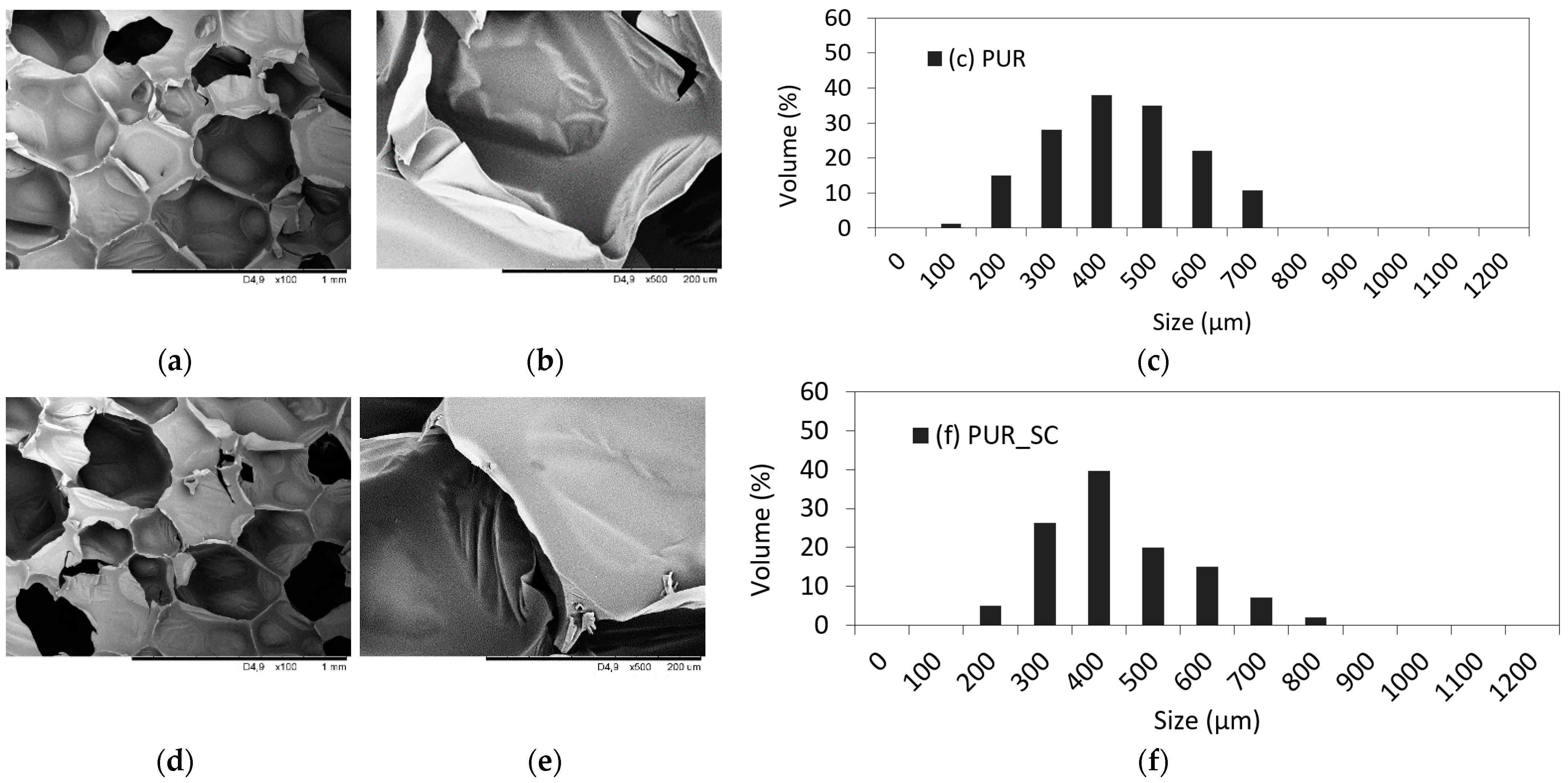
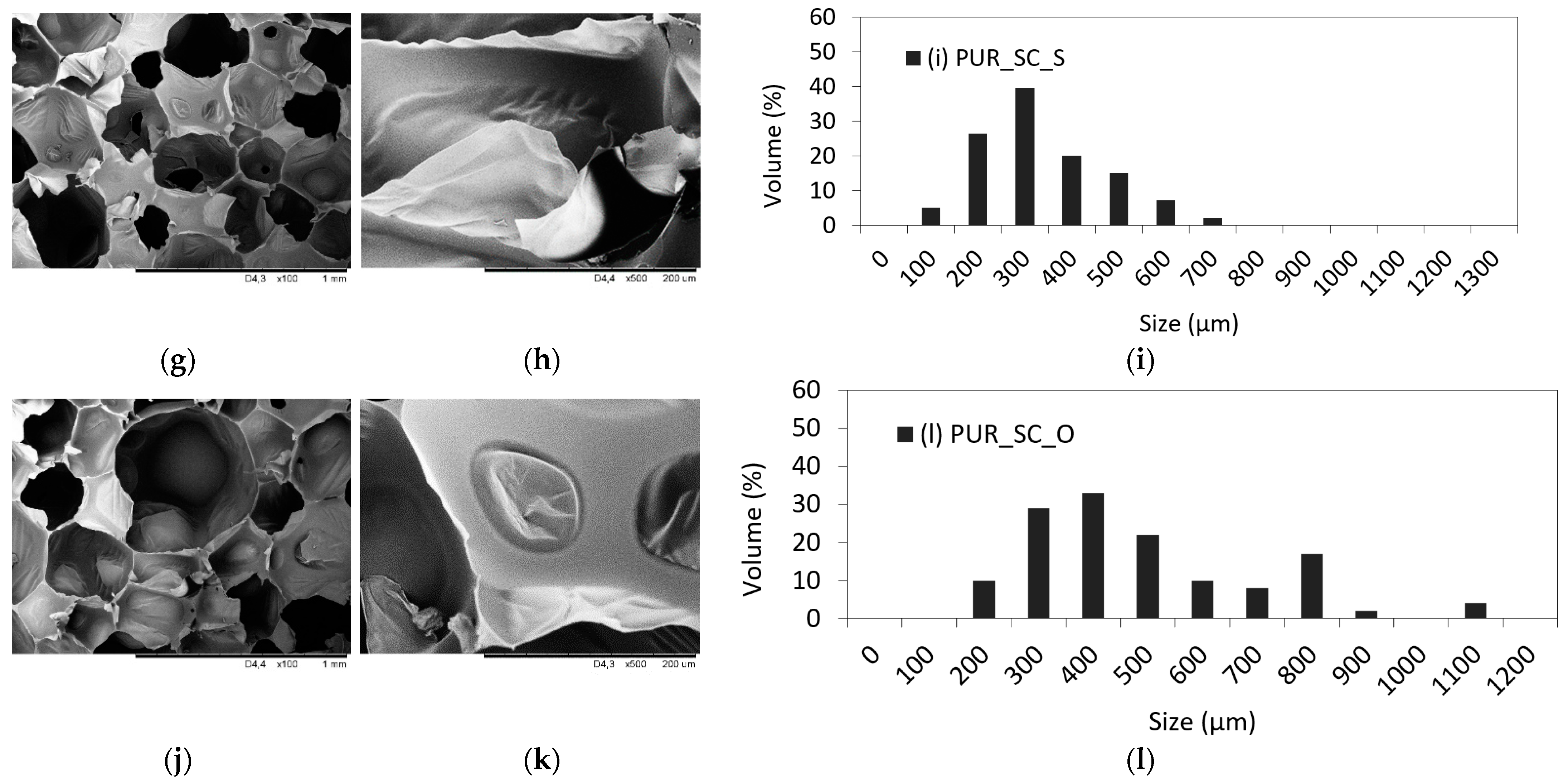
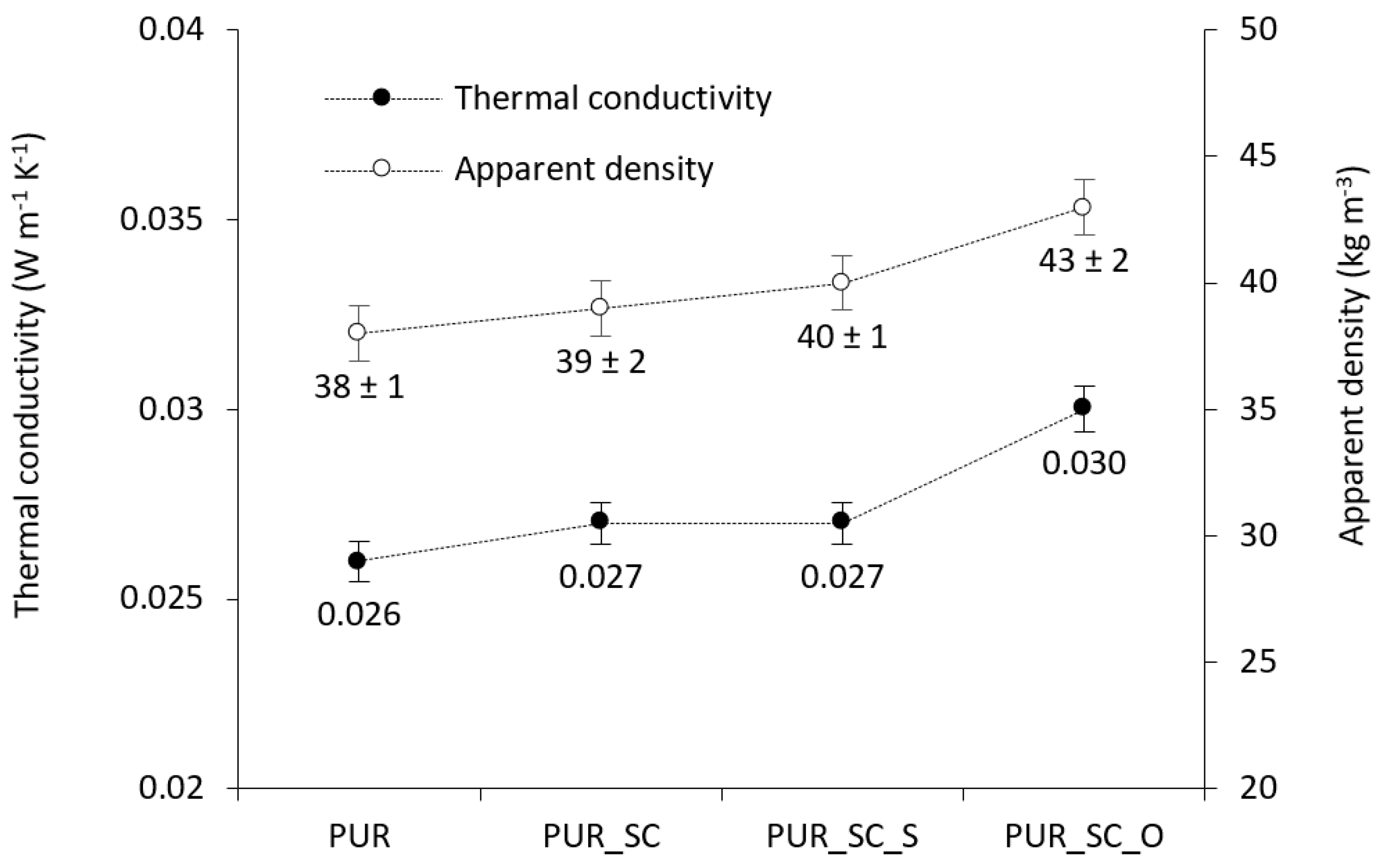

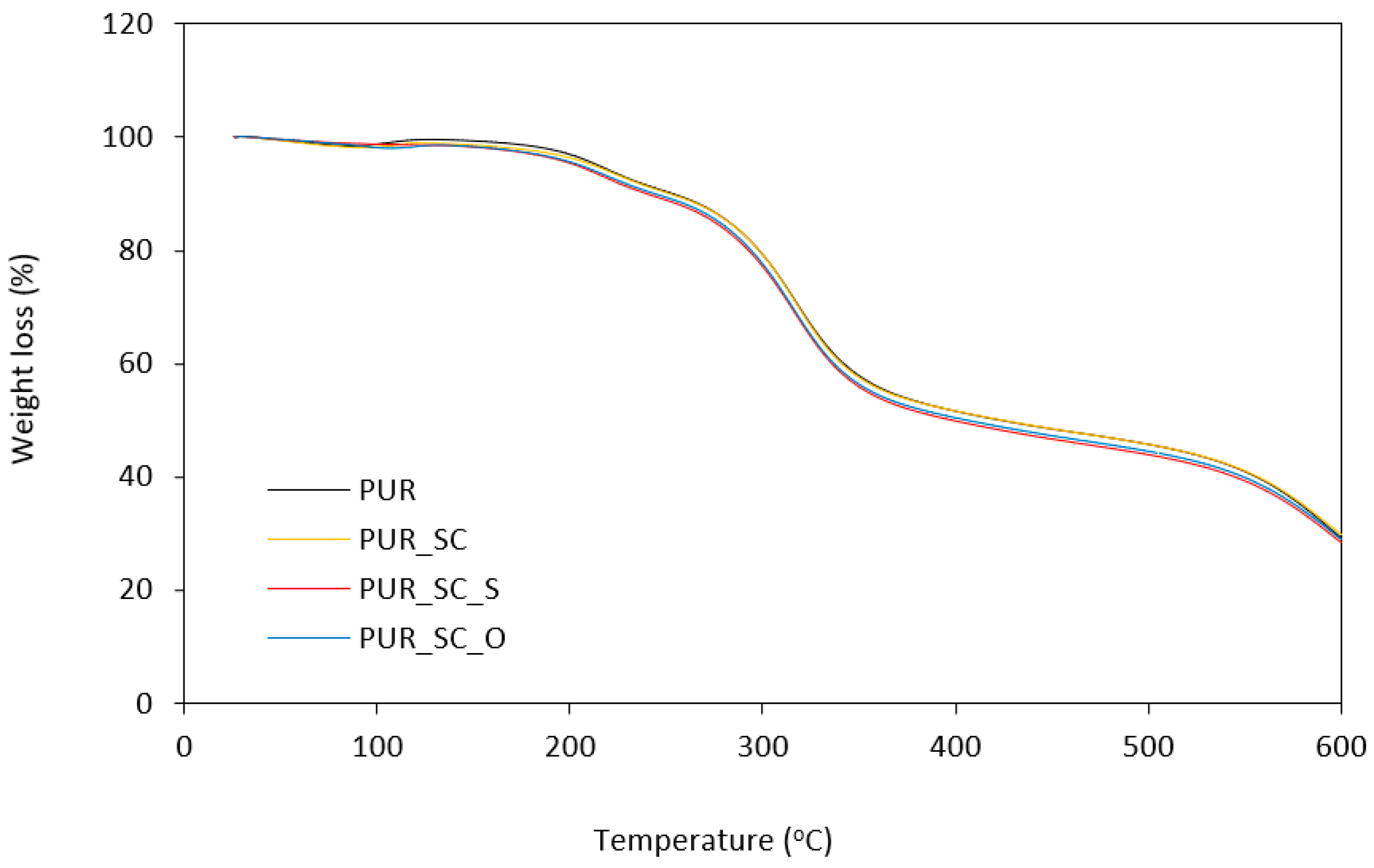
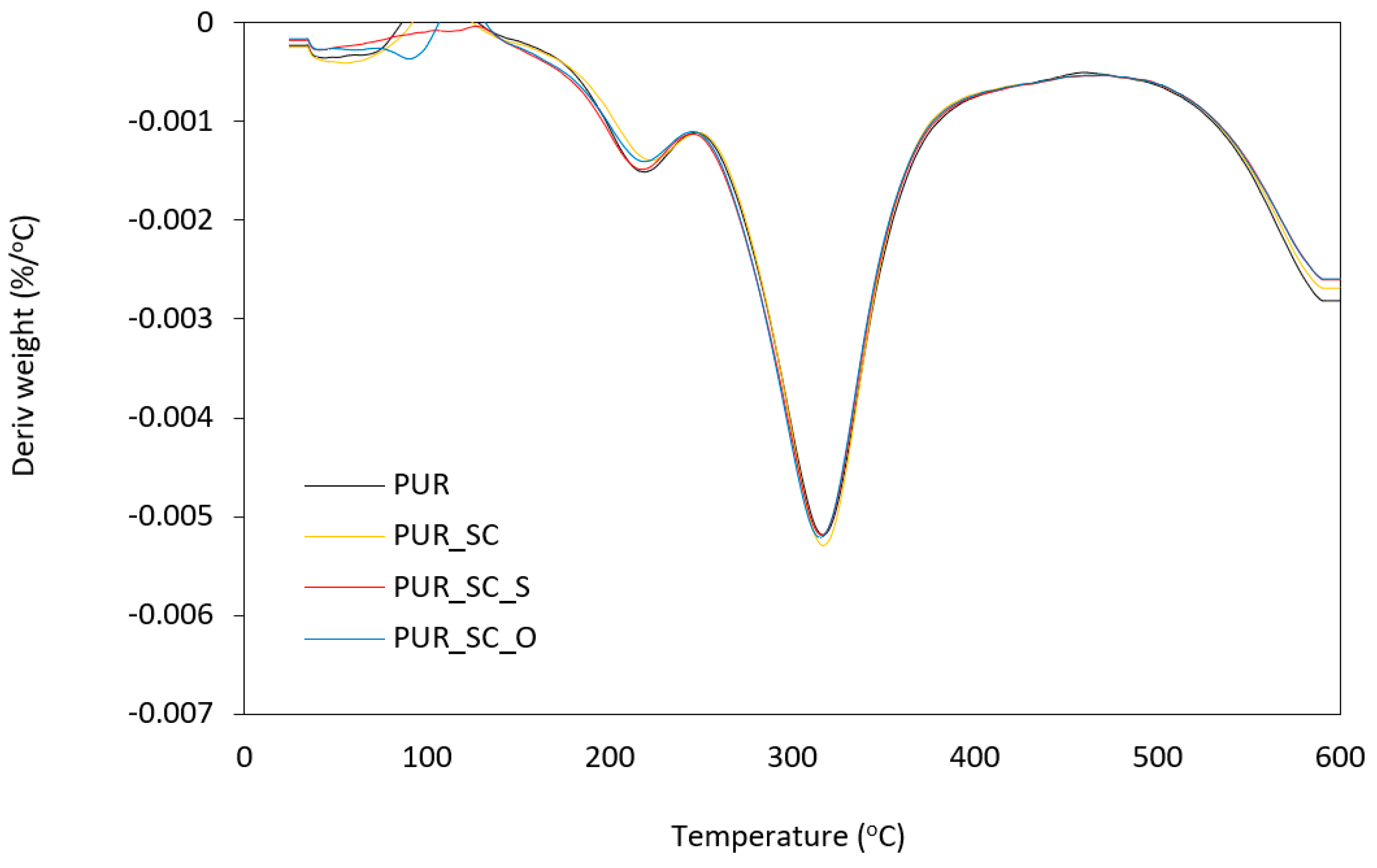
| Component | PUR | PUR_SC | PUR_SC_S | PUR_SC_O |
|---|---|---|---|---|
| Parts by Weight (wt %) | ||||
| STEPANPOL PS-2352 | 100 | 100 | 100 | 100 |
| PUROCYN B | 160 | 160 | 160 | 160 |
| Kosmos 75 | 6 | 6 | 6 | 6 |
| Kosmos 33 | 0.8 | 0.8 | 0.8 | 0.8 |
| Tegostab B8462 | 2.5 | 2.5 | 2.5 | 2.5 |
| Water | 0.5 | 0.5 | 0.5 | 0.5 |
| Pentane/cyclopentane | 11 | 11 | 11 | 11 |
| Sunflower cake (SC) | 0 | 2 | 0 | 0 |
| Silanized sunflower cake (SC_S) | 0 | 0 | 2 | 0 |
| Impregnated sunflower cake (SC_O) | 0 | 0 | 0 | 2 |
| Sample | Dynamic Viscosity η (mPa·s) | Processing Times (s) | ||||
|---|---|---|---|---|---|---|
| 0.5 RPM | 50 RPM | 100 RPM | Cream Time | Growth Time | Tack-Free Time | |
| PUR | 840 ± 9 | 430 ± 7 | 320 ± 8 | 40 ± 2 | 270 ± 9 | 365 ± 9 |
| PUR_SC | 1200 ± 10 | 950 ± 9 | 460 ± 10 | 48 ± 1 | 315 ± 11 | 330 ± 9 |
| PUR_SC_S | 1350 ± 10 | 1000 ± 10 | 490 ± 12 | 45 ± 2 | 330 ± 10 | 335 ± 12 |
| PUR_SC_O | 1800 ± 11 | 1450 ± 12 | 650 ± 11 | 51 ± 2 | 350 ± 9 | 320 ± 8 |
| Sample | Water Absorption (%) | Contact Angle (°) |
|---|---|---|
| PUR | 20 | 123 |
| PUR_SC | 16 | 130 |
| PUR_SC_S | 17 | 125 |
| PUR_SC_O | 10 | 140 |
| Sample | T10% (°C) | T50% (°C) | T80% (°C) | Char Residue (at 600 °C) | DTG (°C) | DTG (%/min) |
|---|---|---|---|---|---|---|
| PUR | 209 | 457 | 585 | 24.4 | 308 | 0.0050 |
| PUR_SC | 206 | 430 | 581 | 22.3 | 309 | 0.0051 |
| PUR_SC_S | 210 | 459 | 586 | 22.3 | 311 | 0.0052 |
| PUR_SC_O | 213 | 468 | 588 | 28.3 | 322 | 0.0056 |
Publisher’s Note: MDPI stays neutral with regard to jurisdictional claims in published maps and institutional affiliations. |
© 2021 by the authors. Licensee MDPI, Basel, Switzerland. This article is an open access article distributed under the terms and conditions of the Creative Commons Attribution (CC BY) license (http://creativecommons.org/licenses/by/4.0/).
Share and Cite
Strąkowska, A.; Członka, S.; Kairytė, A.; Strzelec, K. Effects of Physical and Chemical Modification of Sunflower Cake on Polyurethane Composite Foam Properties. Materials 2021, 14, 1414. https://doi.org/10.3390/ma14061414
Strąkowska A, Członka S, Kairytė A, Strzelec K. Effects of Physical and Chemical Modification of Sunflower Cake on Polyurethane Composite Foam Properties. Materials. 2021; 14(6):1414. https://doi.org/10.3390/ma14061414
Chicago/Turabian StyleStrąkowska, Anna, Sylwia Członka, Agnė Kairytė, and Krzysztof Strzelec. 2021. "Effects of Physical and Chemical Modification of Sunflower Cake on Polyurethane Composite Foam Properties" Materials 14, no. 6: 1414. https://doi.org/10.3390/ma14061414






